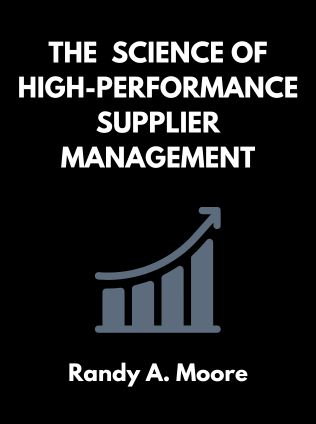
The Science of High-Performance Supplier Management
A Systematic Approach to Improving Procurement Costs, Quality, and Relationships
By Randy A. Moore
Published 10/2001
The Science of High-Performance Supplier Management
A Systematic Approach to Improving Procurement Costs, Quality, and Relationships
By Randy A. Moore, CPM, CPCM
Summary in Brief
Purchasing controls your company's future. To be strategically competitive, supplier relations must be considered at the senior executive level and managed carefully. This summary introduces a high-technology procurement discipline called the Systematic Technology for Procurement (STeP) process to improve supplier relationships. The disciplined techniques presented help establish a proactive supplier performance management environment.
What You'll Learn
- Form and Train a Procurement Team: A team-based approach is superior to traditional deal-making at executive levels.
- Define Procurement Strategy: Identify objectives and hold suppliers responsible for results, encouraging flexibility and responsiveness.
- Prepare a Request for Proposal (RFP): Align objectives, detail requirements, and outline contractual needs to invite solutions focused on meeting your objectives.
- Evaluate and Negotiate: Learn to rate proposals and maintain supplier focus during negotiations.
- Manage Contracts and Reward Results: Monitor and reward superior supplier performance.
Complete Summary
1. Systematic Technology for Procurement (STeP)
Supplier relationships start dysfunctionally as suppliers aim to exchange goods/services for money, while customers exchange money for goods/services. To manage this, create a Supplier Performance Management (SPM) program rather than relying on suppliers' customer relationship management (CRM) programs.
"The objective of your supplier performance management program is simple: to improve the value of your suppliers' performance." — Randy A. Moore
Moore explains that about half of a company's revenues typically go to suppliers, making it crucial for companies to implement strategies that make suppliers more efficient, effective, and innovative. This involves understanding that the value of goods and services has three dimensions: time, quality, and price. Changes in one dimension necessitate adjustments in the others, and this interrelationship forms the basis for effective supplier management.
2. Alignment of Procurement
The first step in the STeP process is aligning procurement objectives with the overall strategic goals of the organization. This involves creating a multidisciplinary procurement team that is clear about its purpose, roles, values, expectations, functions, and goals. Moore stresses the importance of having the right team members, providing proper training, and ensuring that everyone understands how the procurement process fits into the company's objectives.
"Building the right team takes time and money. Don't cut corners." — Randy A. Moore
The procurement team should include representatives from various disciplines, such as end users, legal, procurement, finance, technical experts, technical writers, and senior management. Training the team involves covering team dynamics, roles and goals, tools and techniques, and team decision-making processes. This comprehensive training ensures that the team can work together effectively to manage supplier relationships and procurement processes.
3. Preparation Within the Organization
Once the procurement team is aligned, the next step is detailed preparation. This involves developing a Statement of Work (SOW) that outlines what needs to be done, who will be responsible, where the work will take place, and when it must be completed. The SOW forms the basis for monitoring supplier performance and ensuring that all requirements are clearly communicated.
"Let the supplier worry about the 'how' of performance." — Randy A. Moore
Conducting a market survey is also crucial. This involves gathering external data on technologies and potential suppliers that can meet the organization's needs. Using a Request for Information (RFI) helps identify suitable suppliers by asking for details about their structure, capabilities, and references.
Tailoring the contract to the deal should start early in the process. The contract should be part of the Request for Proposal (RFP) and divided into four sections: administrative elements, the SOW, standard contract language, and specific terms tailored to the deal. This comprehensive approach ensures that all aspects of the procurement are covered and that suppliers are fully aware of the requirements and expectations.
Sign up for FREE and get access to 1,400+ books summaries.
You May Also Like
Rich Dad Poor Dad
What the Rich Teach Their Kids About Money - That the Poor and Middle Class Do Not!
By Robert T. KiyosakiFreakonomics
A Rogue Economist Explores the Hidden Side of Everything
By Steven D. Levitt and Stephen J. DubnerThe Lean Startup
How Today's Entrepreneurs Use Continuous Innovation to Create Radically Successful Businesses
By Eric RiesWho Moved My Cheese?
An Amazing Way to Deal with Change in Your Work and in Your Life
By Spencer Johnson, M.D.Factfulness
Ten Reasons We're Wrong About the World – and Why Things Are Better Than You Think
By Hans RoslingMake Your Bed
Little Things That Can Change Your Life...And Maybe the World
By William H. McRaven



















